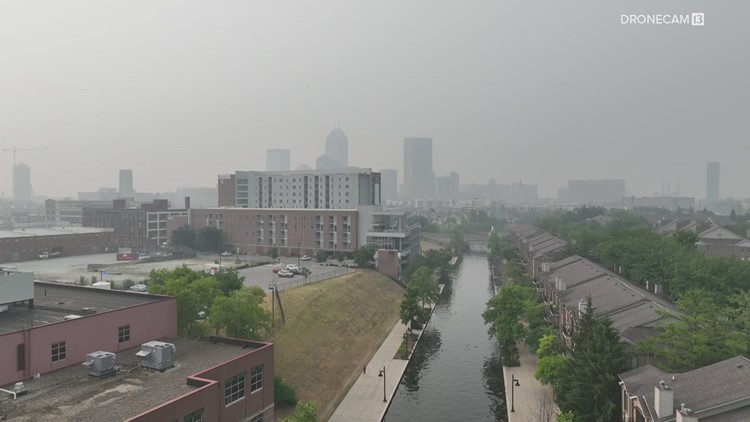INDIANAPOLIS — Feeling like you've suffered a smokier summer than last year? It's not just your imagination. The state's leading environmental organization has recorded nearly double the amount of air quality alerts in 2023 than 2022.
Officials with the Indiana Department of Environmental Management revealed while they issued a total of 13 Air Quality Action Days in 2022, we have already seen nearly double that number well before summer's end.
So far in 2023, 25 Air Quality Action Days have been issued. Of those 25 total alerts, 14 were issued because of ozone pollution, and 10 were issued because of particle pollution from fine particles, or PM 2.5 pollution.
Air quality alerts issued by IDEM can be triggered by both particle and ground level ozone pollution, although 2023 did record one air quality alert so far that resulted from both types of pollution.
Particle pollution has a single pollution source, like soot from fires, dust, factory debris or fossil fuel emissions, which are all examples of particulate matter. In the most recent case, the Canadian wildfires would be the single pollution source that's sending an excess of fine particulate matter into the air.
Fine particulate matter are often referenced by their size, so you could have PM 2.5 or PM 10 particulate matter, which indicate how large the tiny droplets or particles actually are.
Typically though, it's PM 2.5 you'll see referenced by officials because their small size allows them to deposit into the deepest parts of a human lung and into our bloodstream. Larger PM 10 particles can also still settle into our lungs and bodies, but because PM 10 can also include PM 2.5, that particulate size is referenced more often.
Exposure to PM 2.5 particles is something the World Health Organization has named as a major contributor to declines in human health.
Exposure to PM 2.5 has been linked to premature death in people with heart or lung disease, nonfatal heart attacks, and irregular heartbeats. One study from Harvard found more exposure to PM 2.5 is linked to higher rates of death from COVID-19.
Then, there's ground level ozone — also called tropospheric ozone — which is not emitted directly into the air and does not have a direct emissions source. It's a type of pollution created through chemical reactions that happen when oxides of nitrogen and volatile organic compounds interact with sunlight.
Pollutants that are put off by cars, power plants, industrial boilers, refineries, chemical plants and other sources chemically react to the presence of sunlight to create this tropospheric ozone that's not only dangerous for human health, but also a major contributor to climate change.
Even relatively low levels of ground ozone can cause health effects, according to the U.S. Environmental Protection Agency, which said children are at greatest risk from "exposure to ozone because their lungs are still developing" and they are "more likely to be active outdoors" when ozone levels are high.
Depending on the level of exposure, ground ozone can cause coughing and sore or scratchy throat. Exposure can make it more difficult to breathe deeply and vigorously, and can make breathing painful.
While 13News originally reached out to IDEM see if 2023 was outpacing previous years for air quality alerts by a significant amount, the department said they don't have those numbers available.
"Historically, IDEM does not track totals for AQADs issued in a given year," the department said in a statement to 13News.



